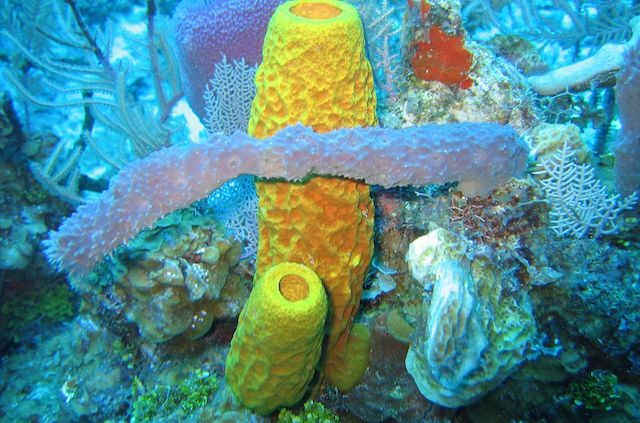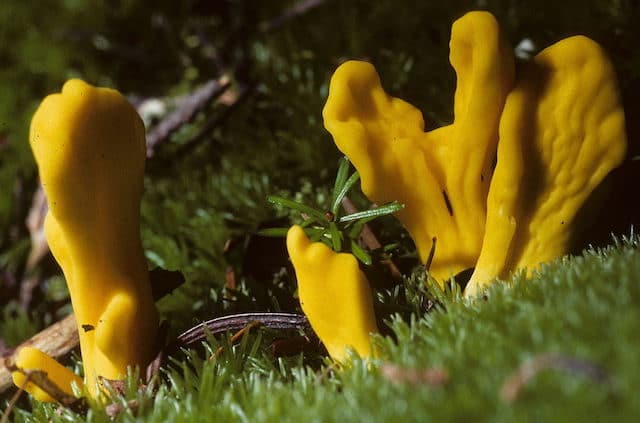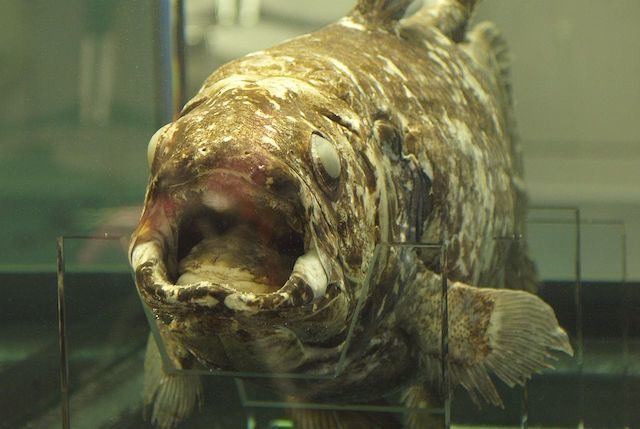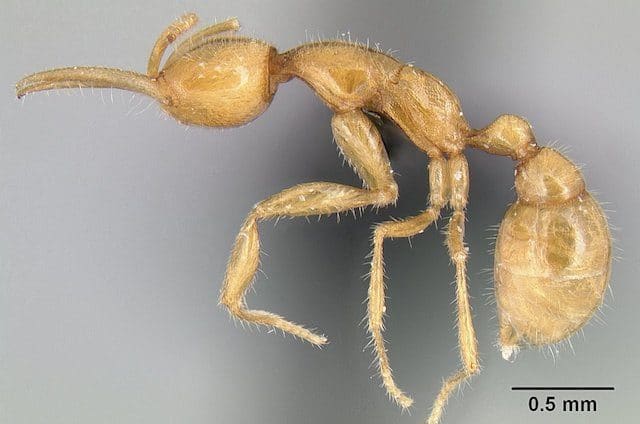According to some new research done by the scientists at the University of California, it seems that life on Earth developed some 4.1 billion years ago, almost the instant the planet formed and 300 million years earlier than previously believed. And once it did, life slowly but surely took over the entire planet. As time went on, and in a continuous process of random variations and mutations, it culminated with what we see all around us today. Of course, this process is still ongoing. Just like history, life changes and moves forward with the passage of time.
Over the millions upon millions of years, life has taken on an immense number of shapes and sizes, some looking more “alien” than others. And the further back we look in time, the weirder life appears. The same way we resemble our parents more than our great-grandparents, so did billion-year-old life look more like what was close to it (in evolutionary terms) than to life today. But still, there are some creatures out there who’ve managed to somehow withstand the test of time and reach the modern age relatively unscathed, even though they appeared as a species earlier than even the dinosaurs themselves. Here are 10 of these “living fossils.”
10. Cyanobacteria – 3.5 billion years

If there was ever someone or something to thank for our existence on Earth in the first place, it would be the Cyanobacteria. Sometimes known as blue-green algae, these bacteria have singlehandedly changed the chemistry of the planet, making it possible for life as we know it to exist. By being the first to make use of photosynthesis in obtaining its energy, Cyanobacteria began releasing oxygen into the atmosphere as a waste product. As time went on, and with more and more of these little critters populating the world’s oceans, a catastrophic event known as the Great Oxygenation Event happened some 2.1 billion years ago, driving almost all previous anaerobic life into extinction.
Becoming the dominant species on the planet, life for the blue-green algae went on. But as even more oxygen was being released, it combined with methane to create carbon dioxide. And since methane is better at being a greenhouse gas than CO2, the planet suddenly cooled in a severe global glaciation, threatening the mighty Cyanobacteria’s very existence. Salvation came with some other, recently-developed organisms that took the new oxygen-rich atmosphere to their advantage. And in fact, the chloroplast in plants today, which they use to photosynthesize, is nothing more than a symbiotic cyanobacterium, taken up by a green algal ancestor of the plants sometime in the Precambrian era. In any case, only one other species has since been able to change the chemistry of the planet’s atmosphere and upset the previously established balance, a member of which is reading this right now.
9. Sponges – 760 million years

Fast forward in time to 760 million years ago and we have the sponge, of all things. It took bacteria more than a billion years before it turned into something else. And the next evolutionary step that we could find in the fossil record is the sponge. Even though the more than 5,000 species of sponge out there today look like plants, they are in fact animals. And the oldest one to have ever been found was the Otavia antiqua, discovered in what is now Namibia and dating back 760 million years. The fossils discovered are the size of a grain of sand, and were quite abundant all those hundreds of millions of years ago. Their small size could indicate that these sponges were in fact the first multicellular animals, and the ancestor of everything we consider today as being “animal.”
Prior to this discovery, made in 2012, the earliest other fossil, also a sponge, was dated to somewhere between 600 to 650 million years ago. Otavia antiqua, on the other hand, stands to show that animals had a 150 million year head start on what we previously believed. This timeline also coincides with the theory put forth by the so called “molecular clock.” The molecular clock hypothesis is, according to geneticists, a condition endemic to all DNA sequences regardless of species, which makes them evolve at a relatively constant rate. By looking back down the evolutionary tree, this theory coincides with when the first multicellular organism should have come into existence, roughly 750 million years ago.
8. Jellyfish – 505 million years
Up until 550 million years ago, life presented itself in a rather peaceful way. Life on land still didn’t exist at this point and the oceans were inhospitable to any modern-day species of fish. There was a gooey mat of microbes inhabiting the sea floor. And there were some creatures, mostly stationary, which resembled flat pillows, that sometimes glided over this carpet of sludge, slowly grazing on these microbes. But then something happened. In an ecological event known as the Cambrian Explosion, which lasted a few million years, the entire face of the Earth changed in terms of the life it harbored. This is the moment when a huge diversity of species emerged, and the moment when carnivory appeared for the very first time. Possibly fueled by a temporary spike in global oxygen levels, or possibly because of the evolution of vision, or maybe a combination of both, life in all its shapes and sizes began a competition among themselves; a literal arms race, which hasn’t stopped even to this day.
Life began to move and diversify like never before. But as many of us know, fossil records don’t really favor soft-bodied life forms. Nevertheless, back in 2007, researchers discovered fossil snapshots of one of the oldest jellyfish ever. Once part of the ocean floor, the state of Utah has revealed four different types of jellyfish dating to more than 500 million years ago. These fossils show a distinct bell-shape body, muscle scars, and tentacles, showing that jellyfish similar to those alive today were roaming the planet’s oceans 200 million years before previously believed.
7. Horseshoe Crabs – 445 million years

The Horseshoe Crab is one obvious candidate in a list filled to the brim with so called “living fossils.” But contrary to their name, these sea-dwelling creatures aren’t really crabs, or any other type of crustacean for that matter. Their closest relatives are actually arachnids, i.e. spiders and scorpions. And like every other species on this list, evolution hasn’t somehow skipped or forgot about the horseshoe crab. The difference between these species, and others that have only “recently” evolved, is just how little these species have changed in regard to their ancestors. This was made possible by the relatively small variations in the environment, which kept them more or less the same over millions of years. The 445-million-year-old horseshoe crabs had, for example, limbs that split out into two branches, whereas today’s specimens have only one.
Thanks to their large numbers, as well as their long existence and influence over the marine environment, many other species are dependent on them for their very survival. As a general rule of thumb, every horseshoe crab female has on average around 90,000 eggs per clutch. However, only about 10 of these make it to maturity, whereas the rest provide for the whole marine food chain. What’s more, their blood is bluish-green. This is because their blood contains copper, which turns this color on contact with air. And unlike our blood, theirs doesn’t have any white blood cells to fight off infection. As a countermeasure, however, their blue blood makes use of some special cells, which trap pathogens inside a gooey physical barrier, thus preventing their spread. Unsurprisingly horseshoe crab blood is highly sought after in the medical community, reaching prices as high as $15,000 per quart.
6. Frilled Sharks – 450 million years
This creature is as elusive as it is frightening. A real monster of the deep, the Frilled Shark inhabits the middle section of the ocean and is spread throughout many coastal areas around the world. It was first scientifically described in 1881, when two specimens were caught in Tokyo Bay. The Frilled Shark may also be the famed mythical Sea Serpent spotted by sailors all around the world in ages past. Anyway, sharks in general are an ancient species and this one in particular is among the oldest. Growing on average to about 4.5 feet in length, it can sometimes reach as much as 6.4 feet, and the first time it was spotted in its natural habitat was only in 2004.
One of its most frightening features is its mouth. While its head somewhat resembles that of a mummified snake, its mouth is filled to the brim with over 300 backward-facing, needle-like teeth. And even though people haven’t actually seen one in action while hunting, scientists speculate that it lures in its prey with the whiteness of its teeth, and then strikes at it like an actual snake. One other interesting fact about this sea monster is the fact that it has the longest gestation period of any animal known to man: 42 months – twice as long as an African elephant. The reason for this long period of gestation is believed by scientists to have something to do with the extreme pressures of the deep.
5. Neolecta – 400 million years

Up until 1969, fungi were classified as plants. This mostly made sense. Even though they look a bit different, they have a stem, roots, and are fixed to the ground or a tree trunk, just like any other plant. But then, it turned out that fungi are not actually plants and, in fact, are more closely related to animals. This is why fungi were awarded their own biological kingdom. With that being said, it turns out that fungi were actually the first organisms to come out of the ocean and make dry land their permanent home. This event took place sometime between 500 and 450 million years ago. Tortotubus is in our fossil record as the first fungus to have done so, with their oldest trace dating back to some 440 million years ago. And what these tiny fungi did was to pave the way for all other forms of life to also “crawl” out of the sea. How? Well, up until that moment in time, there were no nutrients or soil to support any life, only barren rock. And thus, Tortotubus kick-started this process by getting nitrogen and oxygen into the rudimentary soil.
Neolecta, or more commonly, though wrongly, known as “Earth Tongues” are some of their closest relatives, dating back to some 400 million years ago. Even though these resemble other species of fungi like the Geoglossum or Microglossum, which are actually Earth Tongues, Neolecta has no immediate relations. In fact, they are the only genus belonging to the family Neolectaceae, which is the only family belonging to the order Neolectales. And in turn, the Neolectales are the only order belonging to the class Neolectomycetes. Their closest genetic relatives on the evolutionary tree are yeast-like fungi – parasites to both plants and animals – from a group of basal Ascomycota. Another example of their long existence on planet Earth, even before the continents broke apart, is their wide distribution over Asia, Northern Europe, North America, and South Brazil.
4. Coelacanth – 360 million years

Not that long ago, the Coelacanth was believed to have been an extinct species of primitive fish, a precursor to the first amphibians that stumbled out of the sea and onto dry land. The oldest fossil ever found was dated to sometime around 360 million years ago, while the most recent one was from about 80 million years ago (mya). Scientists then safely assumed that the Coelacanth went extinct about the same time as the dinosaurs did, some 65 mya, and that was that. But back in 1938, this whole theory was turned on its head when a live specimen was captured off the coast of South Africa. Latimeria chalumnae, as it came to be named, is just one of the two known species of Coelacanth we know to exist today, with the other one living around Indonesia. Back in its heyday, however, the Coelacanth family was at least 90 species strong, according to the fossil record.
The Coelacanth stands out from other living fish in a number of different ways. Firstly, they have a so called “rostral organ,” which allows the fish to sense the electromagnetic field of an underwater living creature; perfect for hunting in the dark. Secondly, its cranium is able to swing upward, as if it was attached to a hinge. This adaptation allows the Coelacanth to open its mouth much more than other fish. Neither of these two “skills” is found in any other known vertebrae in the world. It also sports a set of limb-like fins that are internally supported by bone. These fins later evolved into legs capable of moving on land.
3. Ginkgo biloba – 270 million years

When it comes to actual plants, the Ginkgo biloba tree is among the oldest species still around today. Like the Neolecta fungi above, the Ginkgo tree has no immediate relatives on the evolutionary… er, tree. Its closest relatives, however, are the Cycads. They are both gymnosperms, meaning that they produce seeds that are on the outside and unfertilized. Ferns, on the other hand, have been around for at least 360 million years, but the species today didn’t appear until roughly 145 million years ago during the early Cretaceous period. Ginkgoes, Cycads, and conifers, on the other hand, came to prominence during the Permian period of the Paleozoic some 270 million years ago, with the Ginkgo resembling its ancestors the most, and being the last living species in its class. Dinosaurs, for example, first evolved from reptiles around 230 million years ago during the Triassic period, at which time Ginkgoes had already been around for more than 40 million years.
Being also considered the oldest genus of seed plants, the now extinct Gingko digitata fossils have been discovered in the Fergana Region of what is now present-day Uzbekistan. The maximum diversity of the Ginkgoales order was achieved during the Jurassic period (206 to 144 mya) when the climate was much warmer and wetter than the previous Triassic Period. With the end of the dinosaur age 65 million years ago, the Gingkoes also went into decline. Their gradual disappearance was possibly caused by the cooling of the climate, the rise of the angiosperms (flowering plants), as well as the demise of the dinosaurs as potential seed dispersers. Gingko biloba, as the sole survivor, endured in some areas of present-day China, where the impact of glaciation was minimal. Also known as the Maidenhair Tree, the Gingko is extremely long-lived, with its oldest individual being dated to 3,500 years ago.
2. The Platypus – 122 million years
Without a doubt, the platypus is one of the weirdest creatures on Earth today. This is because the platypus is a sort of combination between mammals, birds, and reptiles all pushed together to form this strange animal. For starters, it is classified as being a mammal. The word “mammal” itself derives from the mammary glands, which are used to create milk in order to feed their young. The platypus definitely falls in this category, but unlike most other mammals, it lays eggs instead of live babies. These kinds of egg-laying mammals are known as Monotremes, and there are only five such species: the platypus, and four species of spiny anteaters. They are all found in either Australia or New Guinea. Furthermore, the platypus, like most other mammals, has fur covering most of its body, but unlike them, it has a duck-like bill. It also has a gait more similar to reptiles, in that its legs are on the sides of the body rather than underneath. Not to mention the fact that males have a spur on their hind legs that delivers potent venom. And equally strange is the fact that, instead of having a single pair of chromosomes to control their gender (XX for females and XY for males), the platypus has a whopping 5 pairs.
In any case, up until fairly recently scientists believed that platypuses and the spiny anteaters diverged from a common ancestor some 112 million years ago. But later research on the ancient fossil of the Teinolophos has revealed that this was in fact the ancestor of only the platypus, and that the divergence between the species occurred some 10 million years earlier than previously believed. This conclusion was based on some features found in both the fossil itself, as well as modern-day platypuses, and something which the spiny anteaters lack. But because of the small number of fossils from both spiny anteaters and platypuses, this theory is still widely debated. One other possible argument for the platypus being 122 million years old rests with the previously mentioned molecular clock. Monotremes, unlike other mammals, have a slower respiration and metabolic rate, as well as a lower body temperature. These may account for why these species are so old, since they are slow to evolve and change over the millennia.
1. Martialis heureka – 120 million years

Martialis heureka is the oldest species of ants known to man, even though it was only discovered back in 2003, in the Amazonian forest near Manaus, Brazil. Genetically speaking, the Martialis heureka species broke off from the main ant family before the emergence of all 12,000 other known species, being the sole member of the Martialinae subfamily of ants. And because of this, scientists were able to more accurately deduce that all ants have evolved from a prehistoric species of wasp-like creatures that later took to life on the ground. The fact that a single species can tell so much about a whole family of animals is testimony to just how little people know about life and its diversity on the planet. Being so old, the species obviously has some features unlike its other ant cousins, something which gave it its name of Martialis (from Mars), as well as the epithet heureka, which hints at the surprising discovery.
Lacking eyes and having a pale color indicate that the Martialis heureka ant leads an underground lifestyle and only surfaces at night to forage for food. Its two long mandibles indicate that this is a predatory animal which feeds mostly on soft-bodied creatures, like termite larvae. The fact that they are technically blind does not suggest that they evolved from another creature which was also blind, but rather it became this way when it moved underground in order to escape the more aggressive species of ants that evolved at a later time. This amazing discovery also points to the incredibly large number of ecological secrets the tropic regions of the world still hold from us; secrets which may be lost forever due to the disappearance of these habitats.